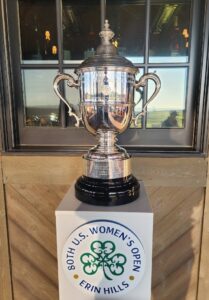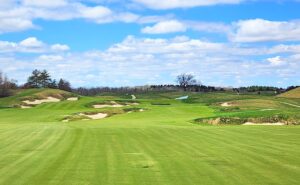Ken Nice – Director of Agronomy at Bandon Dunes Resort In the fourth edition of “Masters of the Moss”, LinksNation traveled across the country to experience Bandon Dunes Resort and it’s 5 spectacular golf courses: Bandon Dunes, Pacific Dunes, Bandon Trails, Old MacDonald and Bandon Preserve (which opens today, May 1st).The Director of Agronomy at Bandon Resort is Ken Nice, he’s a native Oregonian and the man responsible for the care and well being of the terrain that former USGA Executive Director David Fay called “the epicenter of golf on planet earth”. Since Bandon is now regarded as such by many knowledgeable people in the industry, it goes without saying (but I’ll say it here), Ken Nice is one of the most important people in the world of golf today . . . he conducts himself with an air of casualness and a quiet confidence that immediately command your interest and respect. After our initial face to face meeting at Bandon Preserve was cut short by a timely hail storm, Ken and I managed to finally have our Q&A just last week.
LinksNation: There is 85 holes of golf at Bandon, how big is the property at Bandon Resort?
Ken Nice: The entire resort property is 3300 acres.
LN: How large is the staff that you manage?
KN: We have roughly about 100 staffers in the agronomy department
LN: What are the biggest challenges for you with the golf courses on a daily basis?
KN: Probably one of the biggest challenges is how we deal with the wind, not only as it relates to irrigation distribution, but also it can move an amazing amount of sand overnight. Preparing bunkers day in and day out with the north wind howling, it’s such a harsh environment during the summer months. For us the wind is probably our biggest challenge during the high season.
LN: The winds are more severe during the summer months?
KN: Yes, it’s a constant 20-30 mph everyday, it starts in the morning . . . sometimes it does die down at night but you cant always count on that.
LN: That must create an ever evolving set of golf courses.
KN: Yeah, in fact the bunkers at all of the golf courses do evolve over time, they change . . . they are different than at the time of construction. Irrigation distribution and also fertilizer applications become more of a challenge in terms of -When is your window? When is it not? That’s why I think it’s easy for me to identify wind as our greatest challenge, because it impacts so many of our functions. Every property has it’s challenges, it’s always interesting talking to other Superintendents . . . like all things, there is no one right way to do things, but at the same time there are certainly fundamentals out there that all of the best guys don’t stray very far away from.
LN: How many rounds are played at Bandon each year?
KN: Between 120-130 thousand rounds
LN: What’s a typical day for the grounds staff ?
KN: 5am start, crew out the door by 5:30, basically here at Bandon we try to get all of our mowing done ahead of the first group, so that our guests don’t interact with mowers. Then the crew takes lunch and reassembles afterwards to odd projects . . . from there, if it’s busy they might be working on divot repair, that’s something we do daily.
LN: How much different is maintaining these links courses as opposed to a typical American layout?
KN: Certainly the mowing frequency is less, in fact everything is less . . . fertility, irrigation, and mowing. The only thing that is equal to or even possibly more, is our top dressing schedule. That’s something that is a very necessary practice for us. The thing with fine fescue that you find is, it’s not so much what you do, it’s what you don’t do. You have to observe a level of restraint. We rarely verti-cut, you minimize service disturbance with fine fescue as opposed to other grass species. There is very minimal grooming, no hollow core aerification, always small solid tines, we never pull a plug (there have been no plugs ever pulled from the greens at any of the courses at Bandon Dunes).So, basically a combination of low to moderate fertility, a consistent top dressing program and some venting open for infiltration, I see no reason to pull a core. Our goal is to build the profile up, accordingly if you have a perfect profile your building up, why remove it. This helps keep our true firm surface, and also it minimizes some competing grasses. Any annual Bluegrass that may try to move in, has a tough time . . . having no hollow cores open for that, helps our cause.
LN: One of the things I found while there, was how authentic all of the golf courses actually played as links, to a lesser degree with Trails which obviously isn’t on the coast line. I’ve played and reviewed a few courses in the top 100 in America that are links style, but DON’T play like links at all.
KN: Our thinking is Bandon Trails looks like a parkland course, but plays like a links course.
LN: When I was asked by friends and colleagues about the experience of playing the courses at Bandon, other than the obvious things like weather, scenery and the dramatic looks of the holes, I told them “I never hit a lob shot in the 5 rounds I played”! Everything around the greens was along the ground. Even after a torrential rain at Bandon Dunes early a.m that Tuesday (on 4/3), where the greens were under water (and we walked off the course) . . . 4 hours later when I returned to the 1st tee at 12:30 it played firm and fast. That was something I didn’t expect . . . as an American golfer that is something I’d never experienced.
KN: That is something that has been a pride for us, that the golf courses are maintained that way, and that’s the experience that people are going to get when they’re here, we really embrace that we get to maintain authentic links courses in every sense of the word. We feel kind of a connection with all of the guys who are in the U.K and Scotland and what they do, it’s the right property, the right climate the right soils but then most importantly above all is an owner (Mike Keiser) who has a vision and it filtrates down to everybody.
LN: Where did you go to school?
KN: I went to two schools, first went to a school called Willamette in Salem, Oregon and actually graduated from there with a minor in Econ and a major in Psychology. Then I spent about 6 or 7 years as a self employed landscaper. I started to get interested in golf, and thought this is kind of a good combination. My father who was a retired professor at Oregon State at the time, told me about Tom Cook’s Turfgrass program at the University. He’s been the professor to many Superintendents in the Northwest, so at that point I decided it would be a good idea to formalize my education in Landscape & Turf, so I went back to school for another two years and earned my degree in Horticulture and Turfgrass science.
LN: Did being a local and growing up in Oregon help somewhat with knowing the conditions?
KN: I wasn’t too far away from Bandon Resort, maybe a 3 hour drive. It’s kind of different, even though Bandon and Corvallis are only 3 hours apart, it might as well be a 12 hour flight to Scotland . . . you go from the valley and the heavy clay/loam soils to sand and coastal climate, it’s really quite a contrast. It’s nice as an Oregonian, obviously I have a lot of pride in Bandon Dunes and to have the opportunity to work on the property, but also as an Oregonian to have Bandon Dunes here in the state, it’s a double pride thing for me.
LN: What did you learn from having the USGA Pub Links in 2011?
KN: It was actually our 3rd USGA event hosted, we had the ’07 Mid Am and the ’06 Curtis Cup here as well. It always amazes me by just how good these top amateurs are. Their level of skill is always impressive to me, at the same time it’s fun to put on those championships with the USGA and see what tweaks we have to make. There are some logistical things that we learned, but more than anything really is the team effort it takes to put on a USGA event . . . luckily everybody here embraces the Team aspect and everybody jumps in and does their part, no matter what it is.
LN: How involved was the USGA with you in the set up of the courses?
KN: They are very involved, from green speed measurements, to watering. You don’t want to lose control of the golf courses, but at the same time you want it to play firm and fast. We more or less put the cups where they tell us to put it, they are involved in every aspect of the golf course.
LN: Bandon Trails and Old Mac were the courses used for the Pub Links right? Why those two and not the two coastal layouts?
KN: They wanted two contrasting courses, and that was probably about as far apart\ as you could get, at least in terms of our property. Plus Old Mac hadn’t been part of a championship, Pacific has had the Curtis Cup, Bandon was part of the Mid Am, so it was good opportunity to use Trails and Old Mac.
LN: Is there any of the five courses that pose a different or tougher challenge than
the others?
KN: Pacific Dunes has the biggest challenges when it comes to wind, bunker maintenance, water and so forth. Bandon Trails has tree issues to deal with that obviously the other courses don’t.
LN: Bandon Preserve opens May 1st, were you involved in any of the actual construction process with Coore/Crenshaw?
KN: Yeah I was involved in the planning management aspect of it, getting the irrigation contractors and making sure we had the drainage plan. More than anything, just making sure that they have everything they need to do their job, and then obviously from the agronomy side of things, I had a lot to do with the grassing and how we were going to go about it. Feed rates and growing protocols that kind of stuff. I was probably less involved in BP than I was in Old Mac, Pacific, or Trails from a hands on stand point.
It hailed just after meeting Ken at BP, just one of the elements in play on the south coast of Oregon.
LN: I’ve heard Superintendents, including someone I respect a great deal, my friend Matt Shaffer at Merion have told me that the newer style golf shoes with their multi pronged sharp plastic cleats have been more harmful to their courses greens and tees than the old metal spikes. Do you have an opinion on this?
KN: When things start to slow down here in the early fall with our fine fescue we are susceptible to scaring and abrasion, what we call the “fall scuffys” here. Every foot dragger leaves a scar and a scuff, I would think that the modern golf shoe does not help our cause . . . but it’s not a major issue for us, our greens don’t tend to footprint up as the day goes on. They stay pretty true throughout the day, it isn’t really anything that we’re worried about or talk much about during the day.
LN: Last question Ken, but it’s not golf related. I wanted to ask you about your dog Mia . . . I remember when we met, seeing her following you around and you telling me how she was basically abandoned by someone and was living out there in the wild at Bandon Trails (Mia is a black/brown Papillion).
KN: She was out there at least a month that we know of, she is a pretty alert little thing and she must of had a pretty good hiding place there, she had her den somewhere. She was pretty astute at hiding in that den, then from a food standpoint she had been seen by enough people trying to catch her, I know I’d ride by and place a couple biscuits close to where she was hanging out and then I’d come back from the store and I’d see that the biscuits were gone. When they tried to live trap her it took awhile because she wouldn’t go in the cage initially, and so they would set out food and they had to move it incrementally closer everyday. When they finally caught her, I was away on vacation with my wife, we had just arrived in Hawaii and were at baggage claim when the animal control and shelter people from Coos County called me and told me “hey we caught that little black dog, it’s a Papillon” I had promised them if they caught her I would adopt her. I did some research on Papillion’s and she really fits the description to a T. She’s really a bright little dog, they are the #1 small dog during the agility trials. She is great, she is so easy to have out on the golf course, she doesn’t get in anybody’s way. She is definitely a bright spot for me.



